Abstract
A new radioimmunoassay for secretin was used to investigate (a) serum secretin responses to intraduodenally infused HCl and glucose, (b) the metabolic half-life and the volume of distribution of exogenous secretin and (c) the effect of endogenously released secretin on insulin secretion in 25 anesthetized dogs. Portal and femoral venous blood samples were taken simultaneously before, during, and after intraduodenal infusion of HCl (21 meq/30 min) and glucose (131 ml/30 min). Control experiments were performed with intraduodenal infusion of saline.
Mean portal venous immunoreactive secretin concentration of six dogs rose from 313 μU/ml before to 1,060 μU/ml 10 min after initiation of the intestinal acidification (P < 0.005). Femoral venous immunoreactive secretin concentration rose from 220 μU/ml before to 567 μU/ml 15 min after intestinal acidification (P < 0.01). Secretin concentrations remained elevated during the remainder of the infusion.
In the same six dogs mean portal venous immunoreactive insulin concentration rose from 38 μU/ml before to 62 μU/ml at the end of the infusion (P < 0.05). Peripheral immunoreactive insulin, glucose, and free fatty acid concentrations, however, did not change significantly.
Pancreatic exocrine function was studied in four dogs. The rise in secretin concentration was followed promptly by a highly significant increase in exocrine pancreatic flow rate and bicarbonate secretion, indicating biological activity of the circulating immunoreactive secretin.
The effect of intraduodenal infusion of glucose on immunoreactive secretin concentration was studied in 12 dogs. Glucose in concentrations ranging from 2.5% to 10% had no detectable influence on portal or peripheral secretin concentration. Infusion of 50% glucose caused a slight decline in secretin concentration.
The metabolic clearance rate, half-life of disappearance, and volume of distribution of exogenous secretin was studied in three dogs by the constant infusion technic. The metabolic clearance rate was 730±34 ml/min, volume of distribution was 17.4±0.8% of body weight, and the half-life of disappearance was 2.8±0.1 min. It could be calculated that 1.38 U/kg-h-1 of endogenous secretin was released into the peripheral circulation during the steady state period of the HCl infusion experiments.
The data indicated that immunoreactive secretin was released rapidly after intestinal acidification, continued to be secreted throughout the duration of HCl infusion, and was promptly distributed in the extracellular compartment. Furthermore, they suggested that endogenously released secretin could stimulate insulin secretion. The HCl-mediated insulinogenic effect of immunoreactive secretin, however, was too weak to influence peripheral immunoreactive insulin, glucose, and free fatty acid concentrations.
The failure of intraduodenal glucose to stimulate secretin release suggests that secretin is not the insulin-stimulatory factor released from the gastrointestinal tract in response to glucose.
Full text
PDF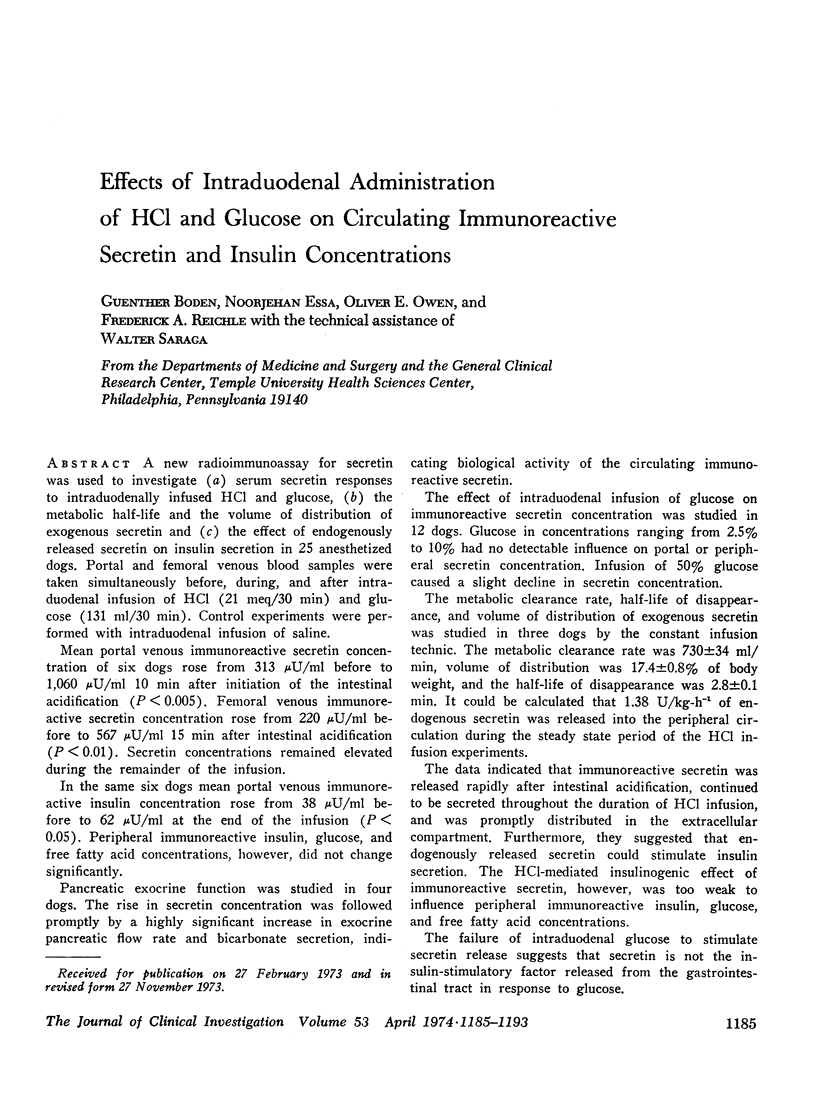
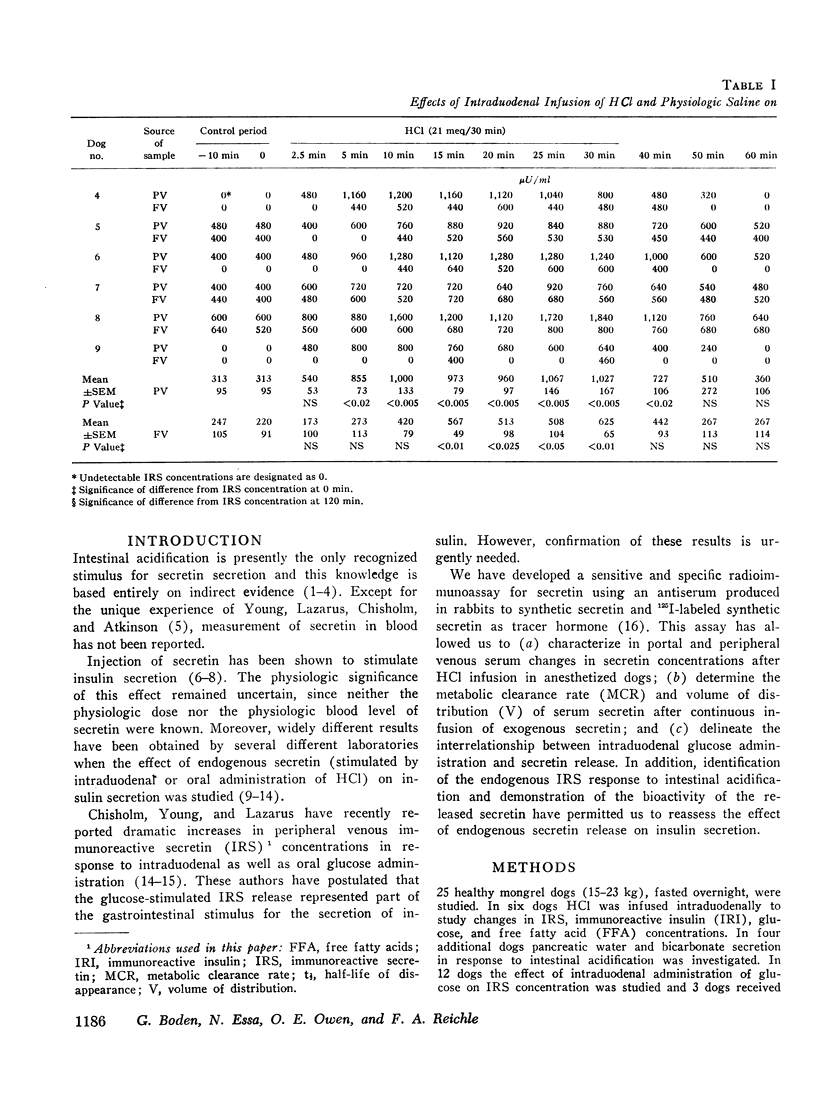
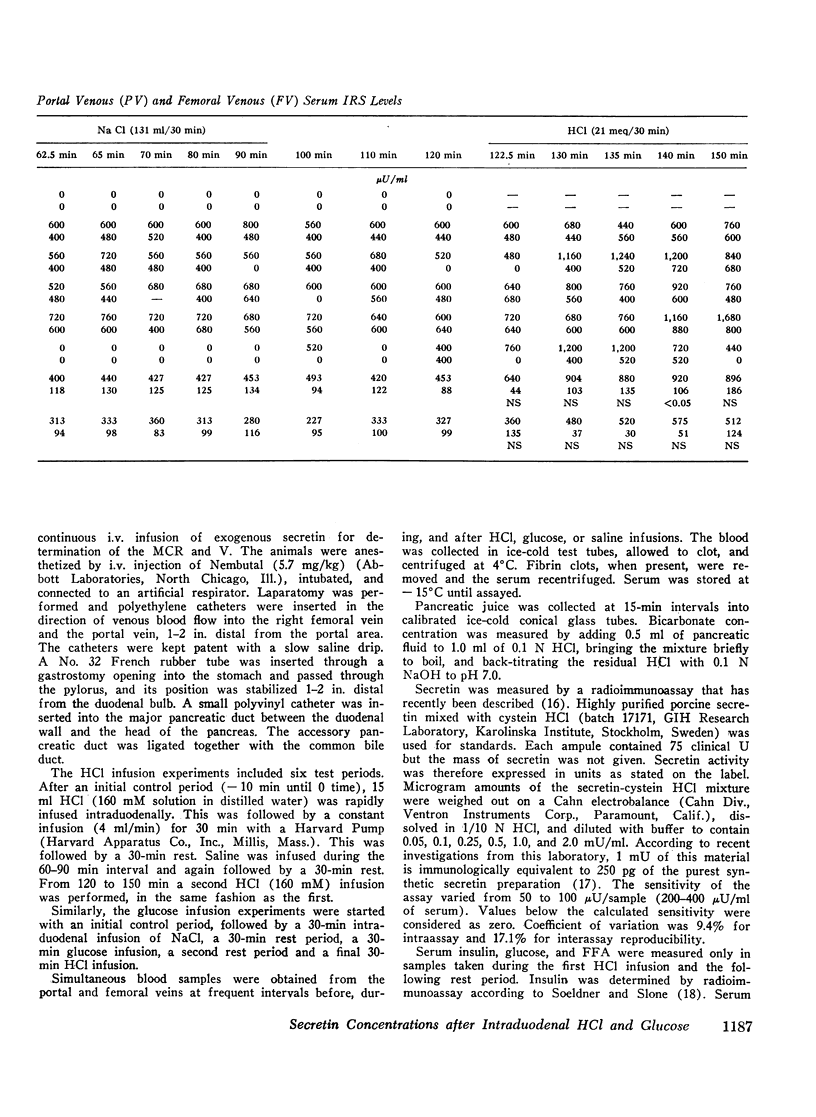
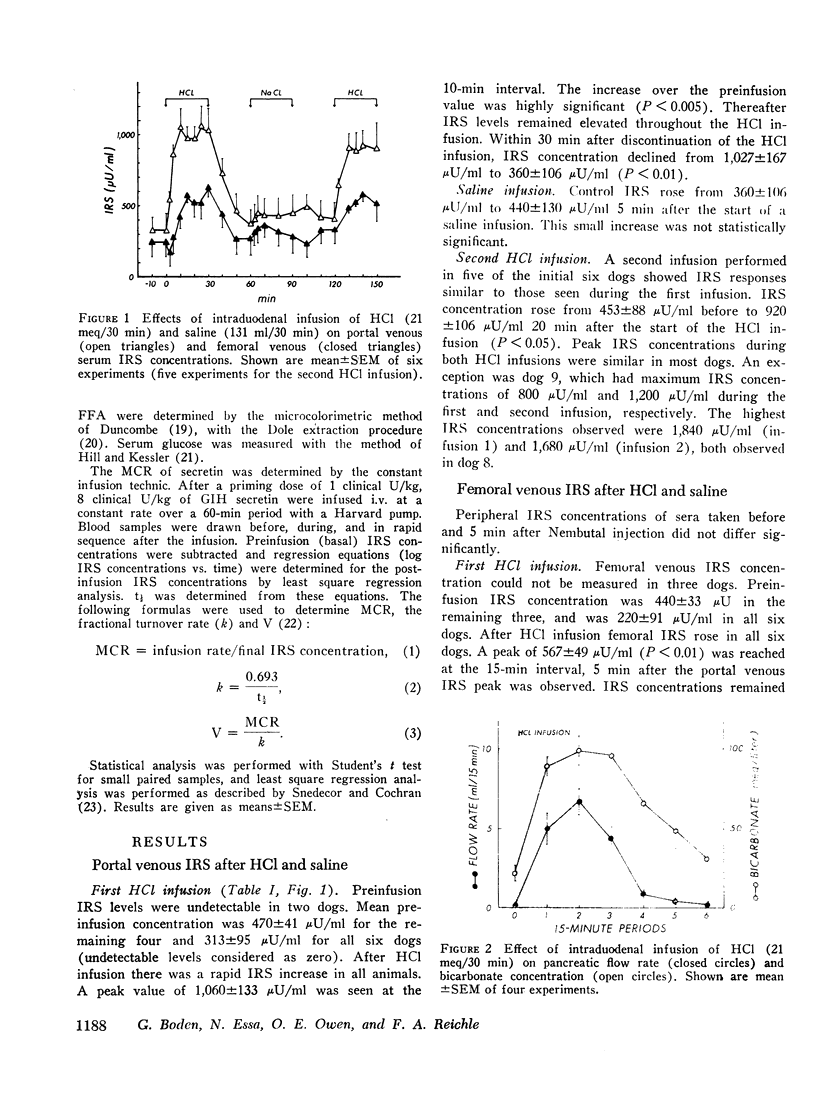
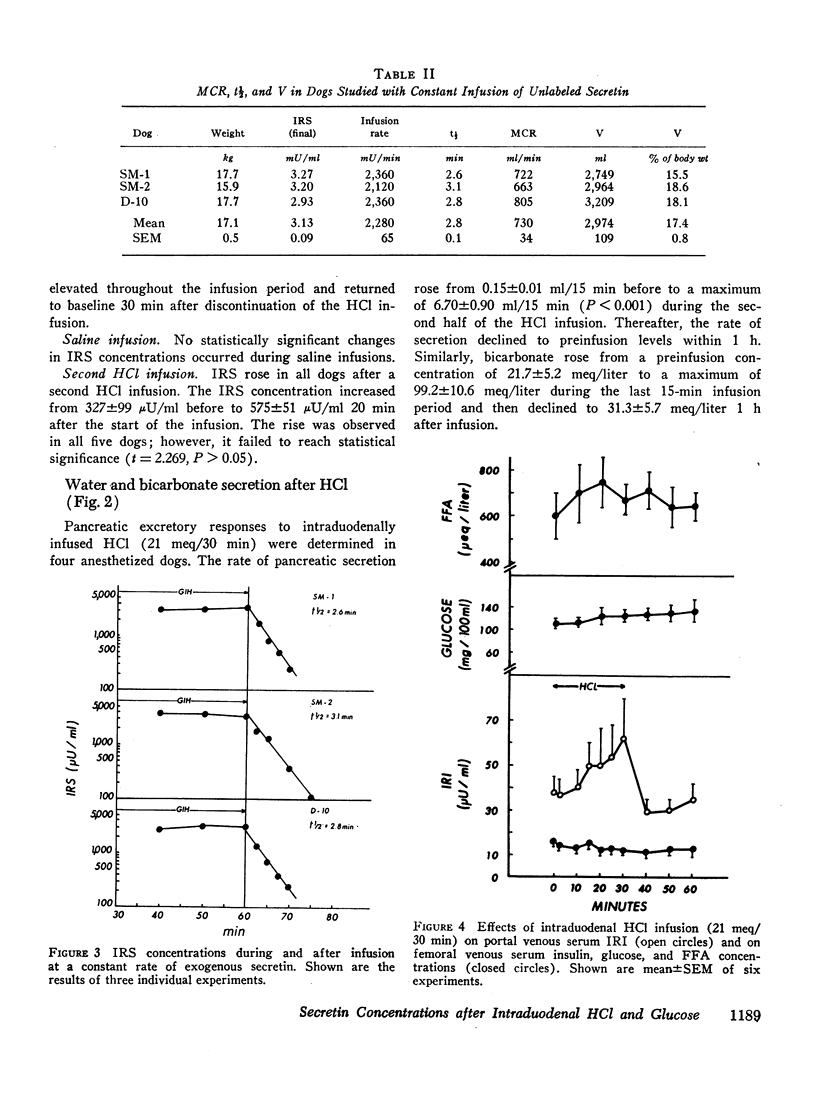
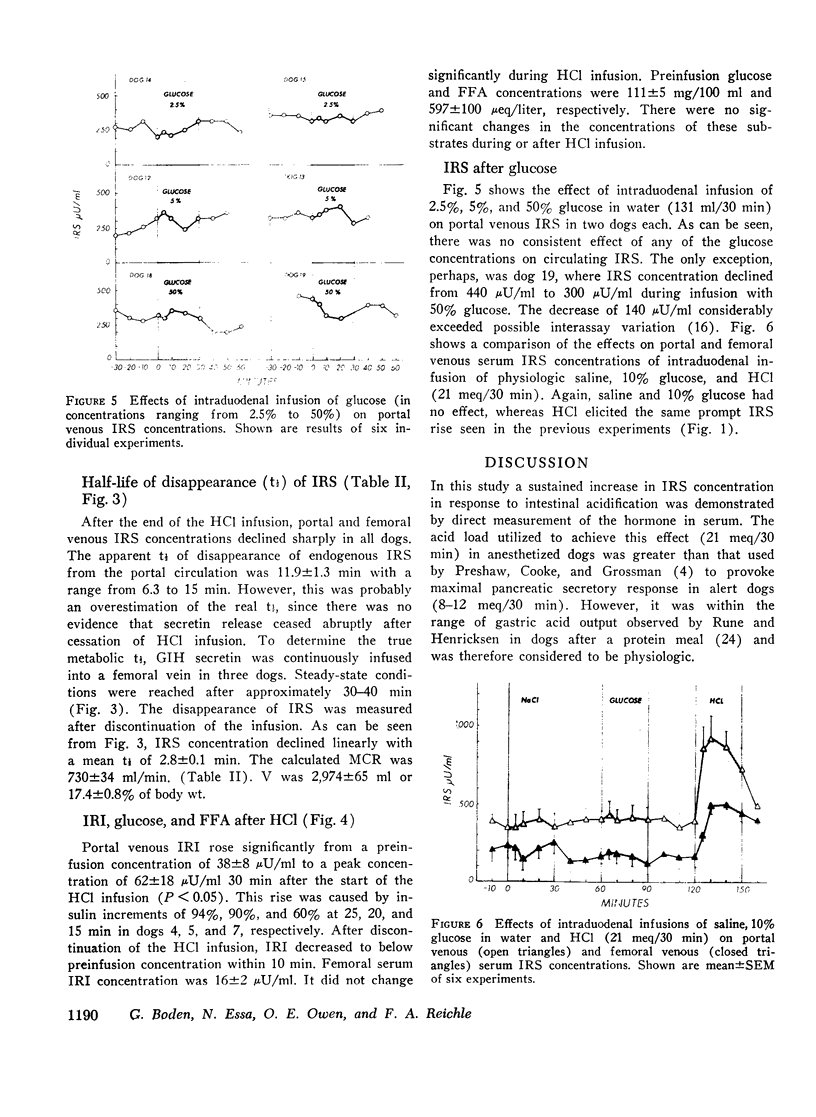
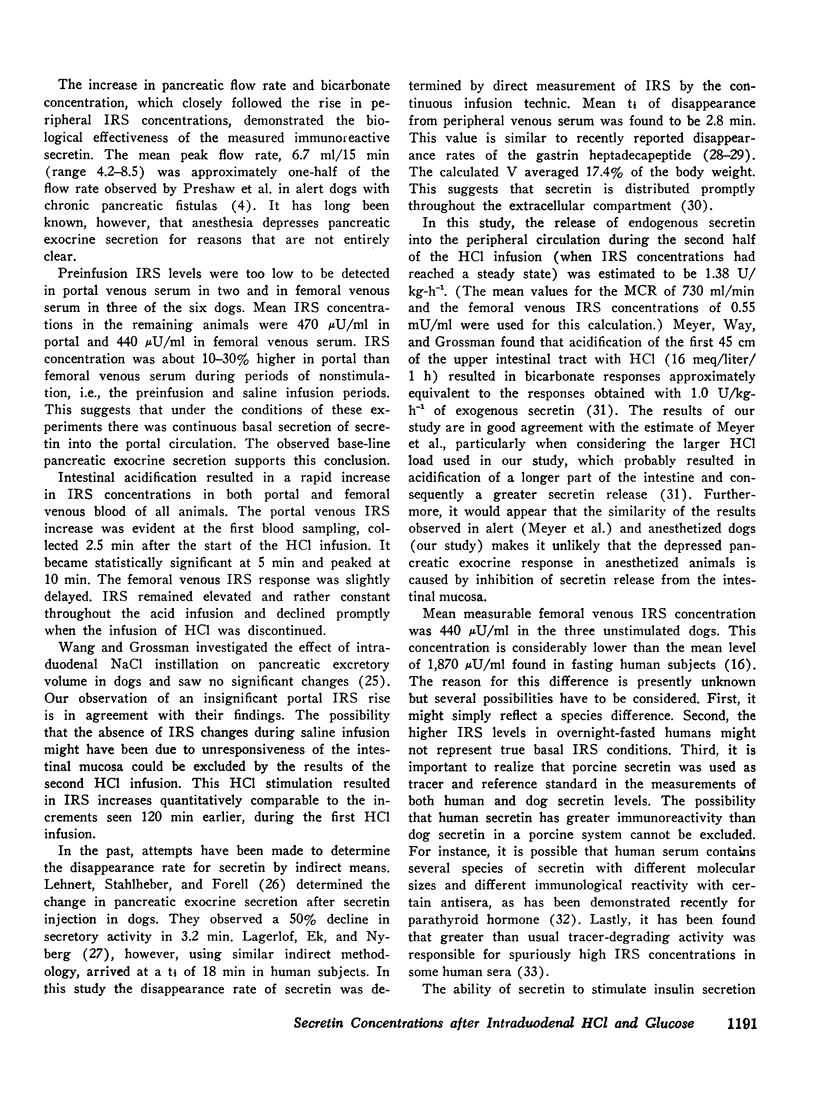
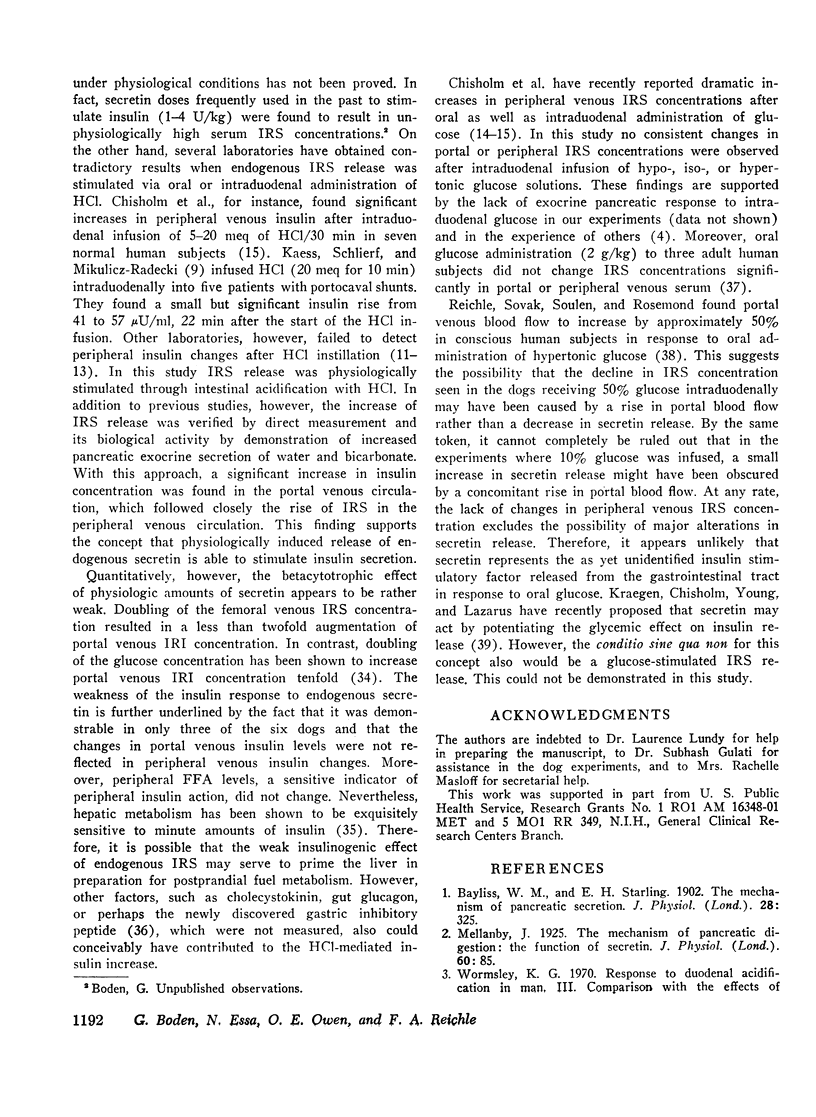
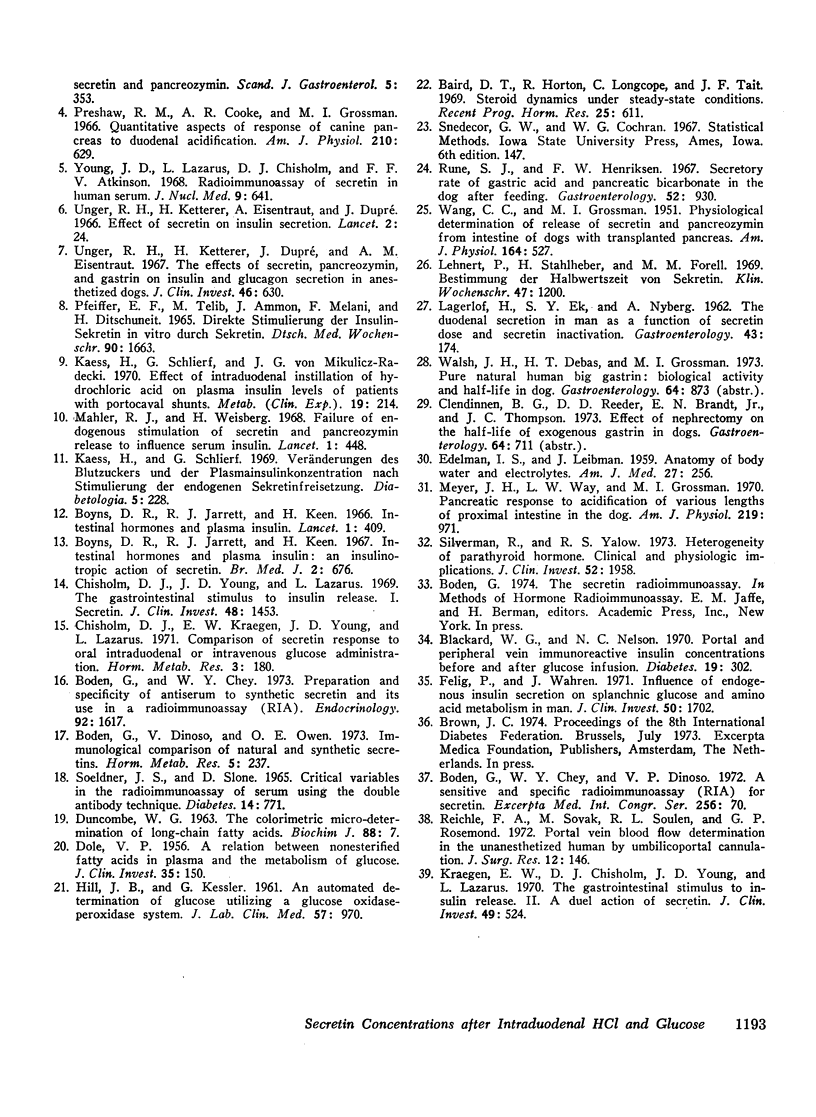
Images in this article
Selected References
These references are in PubMed. This may not be the complete list of references from this article.
- Baird D. T., Horton R., Longcope C., Tait J. F. Steroid dynamics under steady-state conditions. Recent Prog Horm Res. 1969;25:611–664. doi: 10.1016/b978-0-12-571125-8.50017-x. [DOI] [PubMed] [Google Scholar]
- Bayliss W. M., Starling E. H. The mechanism of pancreatic secretion. J Physiol. 1902 Sep 12;28(5):325–353. doi: 10.1113/jphysiol.1902.sp000920. [DOI] [PMC free article] [PubMed] [Google Scholar]
- Blackard W. G., Nelson N. C. Portal and peripheral vein immunoreactive insulin concentrations before and after glucose infusion. Diabetes. 1970 May;19(5):302–306. doi: 10.2337/diab.19.5.302. [DOI] [PubMed] [Google Scholar]
- Boden G., Chey W. Y. Preparation and specificity of antiserum to synthetic secretin and its use in a radioimmunoassay (RIA). Endocrinology. 1973 Jun;92(6):1617–1624. doi: 10.1210/endo-92-6-1617. [DOI] [PubMed] [Google Scholar]
- Boden G., Dinoso V., Owen O. E. Immunological comparison of natural and synthetic secretins. Horm Metab Res. 1973 Jul;5(4):237–240. doi: 10.1055/s-0028-1093957. [DOI] [PubMed] [Google Scholar]
- Boyns D. R., Jarrett R. J., Keen H. Intestinal hormones and plasma insulin: an insulinotropic action of secretin. Br Med J. 1967 Jun 10;2(5553):676–678. doi: 10.1136/bmj.2.5553.676. [DOI] [PMC free article] [PubMed] [Google Scholar]
- Boyns D. R., Jarrett R. J., Keen H. Intestinal hormones and plasma-insulin. Lancet. 1966 Feb 19;1(7434):409–410. doi: 10.1016/s0140-6736(66)91400-0. [DOI] [PubMed] [Google Scholar]
- Chisholm D. J., Kraegen E. W., Young J. D., Lazarus L. Comparison of secretin response to oral intraduodenal or intravenous glucose administration. Horm Metab Res. 1971 May;3(3):180–183. doi: 10.1055/s-0028-1094152. [DOI] [PubMed] [Google Scholar]
- Chisholm D. J., Young J. D., Lazarus L. The gastrointestinal stimulus to insulin release. I. Secretin. J Clin Invest. 1969 Aug;48(8):1453–1460. doi: 10.1172/JCI106111. [DOI] [PMC free article] [PubMed] [Google Scholar]
- DOLE V. P. A relation between non-esterified fatty acids in plasma and the metabolism of glucose. J Clin Invest. 1956 Feb;35(2):150–154. doi: 10.1172/JCI103259. [DOI] [PMC free article] [PubMed] [Google Scholar]
- Duncombe W. G. The colorimetric micro-determination of long-chain fatty acids. Biochem J. 1963 Jul;88(1):7–10. doi: 10.1042/bj0880007. [DOI] [PMC free article] [PubMed] [Google Scholar]
- EDELMAN I. S., LEIBMAN J. Anatomy of body water and electrolytes. Am J Med. 1959 Aug;27:256–277. doi: 10.1016/0002-9343(59)90346-8. [DOI] [PubMed] [Google Scholar]
- Felig P., Wahren J. Influence of endogenous insulin secretion on splanchnic glucose and amino acid metabolism in man. J Clin Invest. 1971 Aug;50(8):1702–1711. doi: 10.1172/JCI106659. [DOI] [PMC free article] [PubMed] [Google Scholar]
- HILL J. B., KESSLER G. An automated determination of glucose utilizing a glucose oxidase-peroxidase system. J Lab Clin Med. 1961 Jun;57:970–980. [PubMed] [Google Scholar]
- Kaess H., Schlierf G. Veränderungen des Blutzuckers und der Plasmainsulinkonzentration nach Stimulierung der endogenen Sekretinfreisetzung. Diabetologia. 1969 Aug;5(4):228–232. doi: 10.1007/BF01212089. [DOI] [PubMed] [Google Scholar]
- Kaess H., Schlierf G., von Mikulicz-Radecki J. G. Effect of intraduodenal instillation of hydrochloric acid on plasma insulin levels of patients with portocaval shunts. Metabolism. 1970 Mar;19(3):214–218. [PubMed] [Google Scholar]
- Kraegen E. W., Chisholm D. J., Young J. D., Lazarus L. The gastrointestinal stimulus to insulin release. II. A dual action of secretin. J Clin Invest. 1970 Mar;49(3):524–529. doi: 10.1172/JCI106262. [DOI] [PMC free article] [PubMed] [Google Scholar]
- LAGERLOF H., EK S. Y., NYBERG A. The duodenal secretion in man as a function of secretin dose and secretin inactivation. Gastroenterology. 1962 Aug;43:174–180. [PubMed] [Google Scholar]
- Lehnert P., Stahlheber H., Forell M. M., Dost F. H., Fritz H., Hutzel M., Werle E. Bestimmung der Halbwertszeit von Secretin. Klin Wochenschr. 1969 Nov 15;47(22):1200–1204. doi: 10.1007/BF01484883. [DOI] [PubMed] [Google Scholar]
- Mahler R. J., Weisberg H. Failure of endogenous stimulation of secretin and pancreozymin release to influence serum-insulin. Lancet. 1968 Mar 2;1(7540):448–451. doi: 10.1016/s0140-6736(68)92780-3. [DOI] [PubMed] [Google Scholar]
- Meyer J. H., Way L. W., Grossman M. I. Pancreatic response to acidification of various lengths of proximal intestine in the dog. Am J Physiol. 1970 Oct;219(4):971–977. doi: 10.1152/ajplegacy.1970.219.4.971. [DOI] [PubMed] [Google Scholar]
- Pfeiffer E. F., Telib M., Ammon J., Melani F., Ditschuneit H. Direkte Stimulierung der Insulin-Sekretion in vitro durch Sekretin. Dtsch Med Wochenschr. 1965 Sep 17;90(38):1663–1669. doi: 10.1055/s-0028-1113397. [DOI] [PubMed] [Google Scholar]
- Preshaw R. M., Cooke A. R., Grossman M. I. Quantitative aspects of response of canine pancreas to duodenal acidification. Am J Physiol. 1966 Mar;210(3):629–634. doi: 10.1152/ajplegacy.1966.210.3.629. [DOI] [PubMed] [Google Scholar]
- Reichle F. A., Sovak M., Soulen R. L., Rosemond G. P. Portal vein blood flow determination in the unanesthetized human by umbilicoportal cannulation. J Surg Res. 1972 Mar;12(3):146–150. doi: 10.1016/0022-4804(72)90099-6. [DOI] [PubMed] [Google Scholar]
- Rune S. J., Henriksen F. W. Secretory rate of gastric acid and pancreatic bicarbonate in the dog after feeding. Gastroenterology. 1967 Jun;52(6):930–939. [PubMed] [Google Scholar]
- Silverman R., Yalow R. S. Heterogeneity of parathyroid hormone. Clinical and physiologic implications. J Clin Invest. 1973 Aug;52(8):1958–1971. doi: 10.1172/JCI107380. [DOI] [PMC free article] [PubMed] [Google Scholar]
- Soeldner J. S., Slone D. Critical variables in the radioimmunoassay of serum insulin using the double antibody technic. Diabetes. 1965 Dec;14(12):771–779. doi: 10.2337/diab.14.12.771. [DOI] [PubMed] [Google Scholar]
- Unger R. H., Ketterer H., Dupré J., Eisentraut A. M. The effects of secretin, pancreozymin, and gastrin on insulin and glucagon secretion in anesthetized dogs. J Clin Invest. 1967 Apr;46(4):630–645. doi: 10.1172/JCI105565. [DOI] [PMC free article] [PubMed] [Google Scholar]
- Unger R. H., Ketterer H., Eisentraut A., Dupré J. Effect of secretin on insulin secretion. Lancet. 1966 Jul 2;2(7453):24–26. doi: 10.1016/s0140-6736(66)91749-1. [DOI] [PubMed] [Google Scholar]
- WANG C. C., GROSSMAN M. I. Physiological determination of release of secretin and pancreozymin from intestine of dogs with transplanted pancreas. Am J Physiol. 1951 Feb;164(2):527–545. doi: 10.1152/ajplegacy.1951.164.2.527. [DOI] [PubMed] [Google Scholar]
- Wormsley K. G. Response to duodenal acidification in man. 3. Comparison with the effects of secretin and pancreozymin. Scand J Gastroenterol. 1970;5(5):353–360. [PubMed] [Google Scholar]
- Young J. D., Lazarus L., Chisholm D. J., Atkinson F. F. Radioimmunoassay of secretin in human serum. J Nucl Med. 1968 Dec;9(12):641–642. [PubMed] [Google Scholar]





